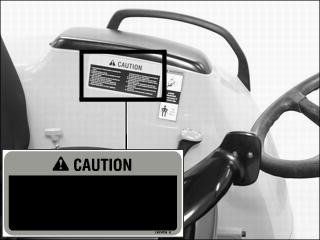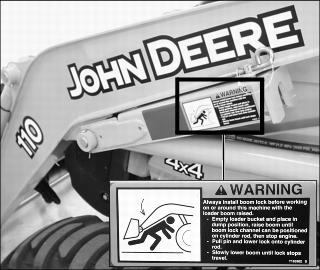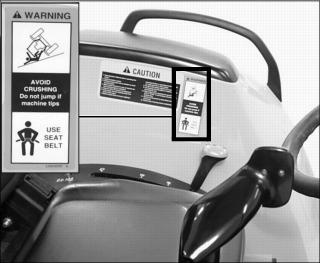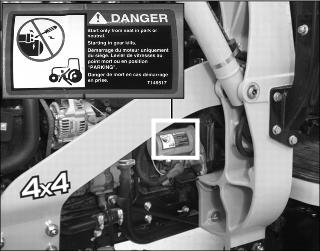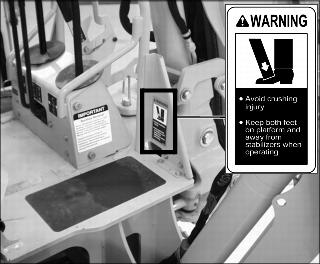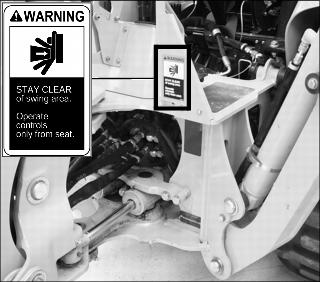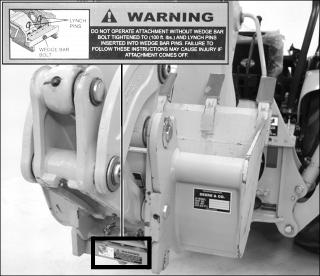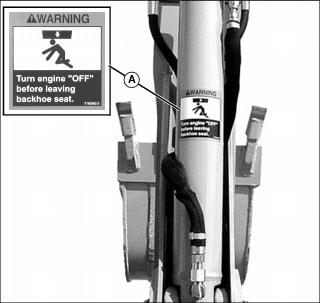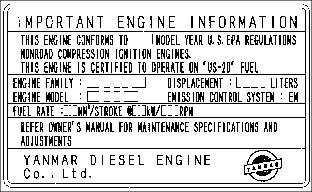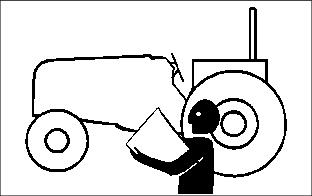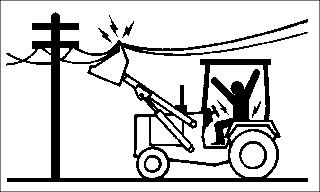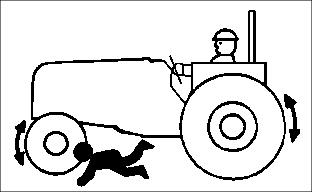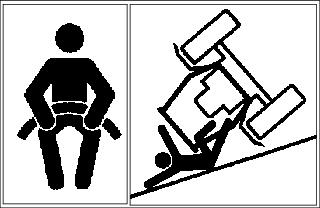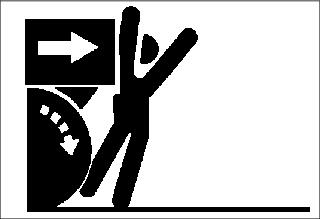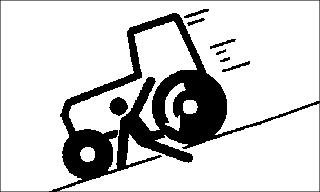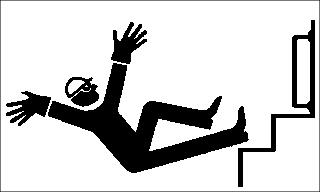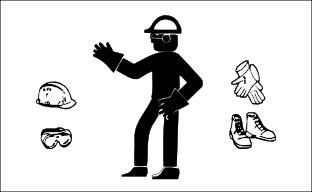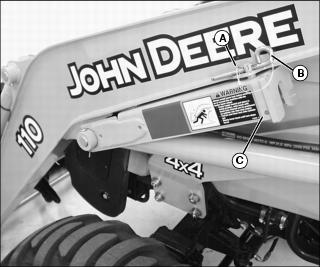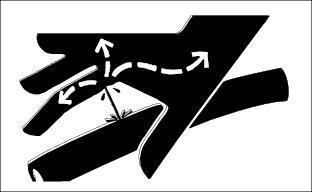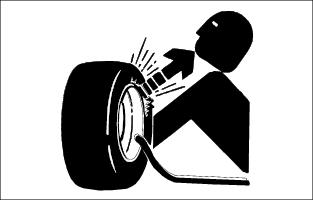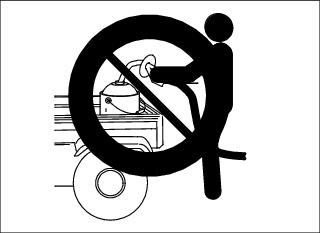
Safety
Understanding The Machine Safety Labels
The machine safety labels shown in this section are placed in important areas on your machine to draw attention to potential safety hazards.
On your machine safety labels, the words DANGER, WARNING, and CAUTION are used with this safety-alert symbol. DANGER identifies the most serious hazards.
The operator's manual also explains any potential safety hazards whenever necessary in special safety messages that are identified with the word, CAUTION, and the safety-alert symbol.
CAUTION
1. Read Operator's Manual before operating this machine.
3. Hitch towed loads only to drawbar to avoid rearward upset.
4. Make certain everyone is clear of machine before starting engine or operation.
5. Keep all riders off machine and equipment.
6. Keep hands, feet and clothing away from power-driven parts.
7. Reduce speed when turning or applying individual brakes or operating around hazards on rough ground or steep slopes.
8. Couple brake pedals together for road travel.
9. Use flashing warning lights on highway unless prohibited by law.
10. Stop engine, lower implement to ground and shift to "PARK" or set brake(s) securely before dismounting.
11. Wait for all movement to stop before servicing machinery.
12. Remove key if leaving machine unattended.
WARNING
Always install boom lock before working on or around this machine with the loader boom raised.
· Empty loader bucket and place in dump position, raise boom until boom lock channel can be positioned on cylinder rod, then stop engine.
· Pull pin and lower lock onto cylinder rod.
· Slowly lower boom until lock stops travel.
WARNING
WARNING
· Keep hands, feet and clothing away.
DANGER
|
Picture Note: Remove left side panel to locate safety label. |
CAUTION: HOT SURFACE
DANGER/POISON
WARNING
WARNING
CAUTION
· AVOID DEATH OR SERIOUS INJURY-Read and understand Operator's Manual before operating this machine.
· Before leaving seat: Lower working tools to ground, place in neutral and engage parking brake.
· Engage backhoe boom and swing locks before transporting.
WARNING
WARNING
WARNING
WARNING
Emissions Control System Certification Label (NonRoad Diesel)
The emissions warranty described in the warranty section applies only to those engines marketed by John Deere that have been certified by the United States Environmental Protection Agency (EPA) and/or California Air Resources Board (CARB); and used in the United States in non-road mobile (self-propelled or portable/transportable1) equipment. The presence of an emissions label like the one shown signifies that the engine has been certified with the EPA and/or CARB. The EPA and CARB warranties only apply to new engines having the certification label affixed to the engine and sold as stated above in the geographic areas governed by the regulating agencies.
NOTE: The hp/kW rating on the engine emissions certification label specifies the gross engine hp/kW, which is flywheel power without fan. In most applications this will not be the same rating as the advertised vehicle hp/kW rating.
Operator Training Required
· The owner of the machine is responsible for training the users and mechanics of the machine.
· The owner/user can prevent and is responsible for accidents or injuries occurring to themselves, other people, or property.
· Do not allow operation or service of the machine by children or untrained adults.
· Read the operator's manual and study the safety and operation sections before operating the machine.
· If the operator of the machine cannot read or understand this manual, it is the machine's owner responsibility to explain this material to the operator. This publication is available in other languages.
· Operate the machine in an open, unobstructed area under the direction of an experienced operator.
· Learn the use of all controls.
· Operator experience is required to learn the moving, stopping, turning and other operating characteristics of the machine.
Operating Machine Safely
· Inspect machine before you operate. Be sure hardware is tight. Repair or replace damaged, badly worn, or missing parts. Be sure guards and shields are in good condition and fastened in place. Make any necessary adjustments before you operate.
· Check before each use that operator presence controls are functioning correctly. Test safety systems. Do not operate unless they are functioning correctly.
· Check brake action before you operate. Adjust or service brakes as necessary.
· Stop machine if anyone enters the area.
· If you hit an object, stop and inspect the machine. Make repairs before you operate. Keep machine and implements properly maintained and in good working order.
· Do not leave machine unattended when it is running.
· Only operate during daylight or with good artificial light.
· Use only accessories and implements approved by the manufacturer of the machine.
Operating Backhoe Safely
· Check with local utility companies before digging to verify location of cables, gas lines and water lines.
· Avoid accidental machine movement. Before turning seat around:
· Lower stabilizers so rear wheels are just off the ground.
· Lower loader bucket to the ground (rolled forward if possible).
· Use the repositioning creeper drive speed control to reposition the machine. On level ground, an experienced operator may use the backhoe bucket to move the machine. Level machine with stabilizers after moving machine.
· Set stabilizers on firm surface. Do not dig under stabilizers. Be alert to possible machine movement when raising stabilizers and loader bucket.
· Avoid swinging bucket downhill when operating on a slope. Dump on uphill side if possible.
· Move boom slowly when raising loaded bucket to full height.
· Clear all persons from area of operation and machine movement.
· If you must drive on slopes, move backhoe to the uphill side for added stability.
Using a Spark Arrestor
The engine in this machine is not equipped with a spark arrestor muffler. It is a violation of California Public Resource Code Section 4442 to use or operate this engine on or near any forest-covered, brush-covered or grass-covered land unless the exhaust system is equipped with a spark arrestor meeting any applicable local or state laws. Other states or federal areas may have similar laws.
A spark arrestor for your machine may be available from your authorized dealer. An installed spark arrestor must be maintained in good working order by the operator.
Avoid Power Lines
Keep away from power lines. Serious injury or death will result. Never move any part of machine or load closer to power line than 3m (10 ft.) plus twice the line insulator length.
Protect Children and Prevent Accidents
Protect Children:
· Never assume that children will remain where you last saw them. Children are attracted to machine activity; stay alert to the presence of children.
· Turn machine off if a child enters the worksite.
· Use extra care when you come to blind corners, shrubs, trees, or other objects that may block your vision.
· Do not carry or let children ride on machine or any attachment.
Help Prevent Serious Or Fatal Accidents:
· Be alert at all times; drive forward carefully. People, especially children, can move quickly onto the worksite unnoticed.
· An operator must continuously be aware of all co-workers who share the worksite.
· Back up carefully. An operator must always look to each side and to the rear for co-workers before backing up.
Parking Safely
1. Stop machine on a level surface, not on a slope.
2. Lower all attachments to the ground.
3. If servicing engine, raise front loader boom and install loader boom service lock.
7. Wait for engine and all moving parts to stop before you leave the operator's station.
Avoid Injury From Rollover Accidents
· Wear your seat belt. Do not jump to clear tipping machine. Machine will tip over faster than the operator can jump free.
· Be careful when operating on a slope.
· Balance loads so weight is evenly distributed and load is stable.
· Carry tools close to the ground to aid visibility and lower the center of gravity.
· Reduce speed before turning or swinging load.
· Know capacity of machine. Do not overload.
· Be careful when operating at the edge of an excavation, trench, or drop-off, and loading or unloading from a trailer.
Avoid Injury From Backover Accidents
· Know the location of bystanders before moving the machine.
· Always look behind you before you back up. Be sure that everyone is out of the way before moving the machine.
· Use horn or other signal to warn bystanders before moving machine.
· Keep bystanders away from pivot area of an articulated machine.
· Keep reverse warning alarm in working condition to warn people when machine starts to move in reverse.
· Use a signal person when backing up if view is obstructed and in congested areas. Always keep the signal person in view.
· Learn the meaning of all flags, signs and markings used on the job, and who has responsibility for signaling.
· Keep windows, mirrors, and lights clean and in good condition.
· Dust, heavy rain and fog can reduce visibility. As visibility decreases, reduce speed and use proper lighting.
Avoid Injury From Rollaway Accidents
· Always make sure the machine is properly secured and park safely before leaving the operator's station.
· Do not attempt to get on or stop a moving machine.
· Position the machine or block the wheels to prevent the machine from rolling.
Using Handholds and Steps
· Falling is a major cause of personal injury. Keep steps and platform clean and dry if possible.
· Be careful of slippery conditions on platforms, steps, and handrails when leaving the machine.
· When you get on and off the machine, always maintain a three point contact with steps and handrails and face the machine. Do not use steering wheel or any controls as handholds.
· Never jump on or off the machine. Never mount or dismount a moving machine.
Use Seat Belt Properly
· Use a seat belt when you operate with a Roll-Over Protective Structure (ROPS) to minimize chance of injury from an accident, such as an overturn.
· Do not use a seat belt if operating without a ROPS or cab.
· Replace entire seat belt if mounting hardware, buckle, belt, or retractor show signs of damage.
· Inspect seat belt and mounting hardware at least once a year. Look for signs of loose hardware or belt damage, such as cuts, fraying, extreme or unusual wear, discoloration, or abrasion. Replace only with replacement parts approved by your John Deere dealer.
Keep Riders Off
· Only allow the operator on the machine. Keep riders off.
· Riders on the machine or implement may be struck by foreign objects or thrown off the machine causing serious injury.
· Riders obstruct the operator's view resulting in the machine being operated in an unsafe manner.
Checking Wheel Bolts
· A serious accident could occur causing serious injury if wheel bolts are not tight.
· Check wheel bolt tightness often during the first 100 hours of operation.
· Wheel hardware must be tightened to specified torque using the proper procedure anytime it is loosened.
Wear Appropriate Clothing
· Always wear safety goggles or safety glasses with side shields and hard hat when operating the machine.
· Wear a suitable protective device such as earplugs. Loud noise can cause impairment or loss of hearing.
· Do not wear radio or music headphones. Safe service and operation requires your full attention.
Driving Safely on Public Roads
· Slow down and be careful of traffic when operating near or crossing roadways.
· Set boom lock and swing lock pins to center backhoe before driving.
· Lock brake pedals together and lower loader bucket before driving.
· Use safety lights and devices. Slow moving machines when driven on public roads are hard to see, especially at night.
· Use extra care when loading or unloading the machine into a trailer or truck.
· Check state and local regulations for tow vehicle and trailering requirements before transporting the Tractor Loader Backhoe. A trailer with a minimum 4536kg (10,000 lb) gross vehicle weight rating (GVWR) and an appropriate tow vehicle are required to transport the machine. Carrying additional equipment on the trailer will increase the GVWR requirement.
· Whenever driving on public roads, use flashing warning lights and turn signals according to state and local regulations.
Practice Safe Maintenance
· Only qualified, trained adults should service this machine.
· Understand service procedure before doing work. Keep area clean and dry.
· Warn others of service work. Before performing any work on the machine, attach a "DO NOT OPERATE" tag to the steering wheel.
· Never lubricate, service, or adjust machine while it is moving. Keep safety devices in place and in working condition.
· Keep hands, feet, clothing, jewelry, and long hair away from any moving parts, to prevent them from getting caught.
· Stop machine on a level surface and lower implements to the ground before servicing machine. Disengage all power and stop the engine. Lock park brake and remove the key. Let machine cool.
· Before doing service work under the engine hood, raise front loader boom and install loader boom service lock.
· Disconnect battery or remove spark plug wire (for gasoline engines) before making any repairs.
· Before servicing machine, carefully release pressure from components with stored energy such as hydraulic components.
· Keep all nuts and bolts tightened.
· Securely support any machine elements that must be raised for service work. Lock service latches before working on machine with raised implements.
· Use jack stands to support components when needed.
· Never run engine unless park brake is locked.
· Keep all parts in good condition and properly installed. Fix damage immediately. Replace worn or broken parts.
· Replace all worn or damaged safety and instruction decals. Newly-installed parts must include current safety labels specified by the manufacturer.
· To prevent fires, remove any buildup of grease, oil, or debris from the machine, especially the engine compartment.
· Charge batteries in an open, well-ventilated area, away from sparks. Unplug battery charger before connecting or disconnecting from the battery. Wear protective clothing and use insulated tools.
· Do not modify machine or safety devices. Unauthorized modifications may impair its function and safety.
· Do not wear radio or music headphones while servicing the machine. Safe service requires your full attention.
Using Loader Boom Service Lock
Installing Loader Boom Service Lock
Install loader boom service lock when front loader must be raised for service procedures.
1. Empty loader bucket and place in dump position.
Picture Note: Storage position shown.
2. Raise boom until boom lock channel can be positioned on cylinder rod, then stop engine.
3. Remove spring locking pin (A) and retaining pin (B) and lower lock onto cylinder rod.
4. Install retaining pin (B) in lock hole (C) and secure with spring locking pin (A).
5. Slowly lower boom until weight settles onto the loader boom service lock.
Removing Loader Boom Service Lock
2. Raise boom slightly to allow clearance between loader boom service lock and cylinder.
3. Remove spring locking pin and retaining pin.
4. Lift loader boom service lock to storage position.
5. Install the retaining pin and spring locking pin.
Prevent Machine Runaway
· Do not start engine by shorting across starter terminals. Machine will start in gear if normal circuitry is bypassed.
· Never start engine while standing on ground. Start engine only from operator's seat, with transmission in neutral or park.
Keep ROPS Installed Properly
· Make certain all parts of the ROPS are installed correctly if the ROPS structure is loosened or removed for any reason. Tighten all hardware to the proper torque.
· The protection provided by the ROPS will be impaired if the ROPS is subjected to structural damage, is involved in an overturn incident, or is in any way altered by welding, bending, drilling, or cutting. A damaged ROPS should be replaced.
Remove Paint Before Welding or Heating
· Avoid potentially toxic fumes and dust.
· Hazardous fumes can be generated when paint is heated by welding, soldering, or using a torch.
· Remove paint before heating:
· Remove paint a minimum of 76mm (3 in.) from areas to be affected by heating.
· If you sand or grind paint, avoid breathing the dust. Wear an approved respirator.
· If you use solvent or paint stripper, remove stripper with soap and water before welding. Remove solvent or paint stripper containers and other flammable material from area. Allow fumes to dispense at least fifteen minutes before welding or heating.
· Do all work in an area that is ventilated to carry toxic fumes and dust away.
· Dispose of paint and solvent properly.
Avoid Heating Near Pressurized Fluid Lines
Flammable spray can be generated by heating near pressurized fluid lines, resulting in severe burns to yourself and bystanders. Do not heat by welding, soldering or using a torch near pressurized fluid lines or other flammable materials. Pressurized lines can be accidently cut when heat goes beyond the immediate flame area.
Avoid High Pressure Fluids
· Hydraulic hoses and lines can fail due to physical damage, kinks, age, and exposure. Check hoses and lines regularly. Replace damaged hoses and lines.
· Hydraulic fluid connections can loosen due to physical damage and vibration. Check connections regularly. Tighten loose connections.
· Escaping fluid under pressure can penetrate the skin causing serious injury. Avoid the hazard by relieving pressure before disconnecting hydraulic or other lines. Tighten all connections before applying pressure.
· Search for leaks with a piece of cardboard. Protect hands and body from high pressure fluids.
· If an accident occurs, see a doctor immediately. Any fluid injected into the skin must be surgically removed within a few hours or gangrene may result. Doctors unfamiliar with this type of injury should reference a knowledgeable medical source. Such information is available from Deere & Company Medical Department in Moline, Illinois, U.S.A. Information may be obtained in the United States and Canada only by calling 1-800-822-8262.
Prevent Fires
· Never remove fuel cap, or add fuel with engine running or hot. Allow engine to cool for several minutes.
· Never store equipment with fuel in the tank inside a building where fumes may reach an open flame or spark.
· Allow engine to cool before storing in any enclosure.
· To reduce fire hazard, keep engine free of grass, leaves, or excessive grease.
Tire Safety
Explosive separation of a tire and rim parts can cause serious injury or death:
· Do not attempt to mount a tire without the proper equipment and experience to perform the job.
· Always maintain the correct tire pressure. Do not inflate the tires above the recommended pressure. Never weld or heat a wheel and tire assembly. The heat can cause an increase in air pressure resulting in a tire explosion. Welding can structurally weaken or deform the wheel.
· When inflating tires, use a clip-on chuck and extension hose long enough to allow you to stand to one side and NOT in front of or over the tire assembly.
· Check tires for low pressure, cuts, bubbles, damaged rims or missing lug bolts and nuts.
Handling Fuel Safely
Fuel and fuel vapors are highly flammable and explosive:
· Do not refuel machine while you smoke, when machine is near an open flame or sparks, or when engine is running. Stop engine and allow to cool before filling.
· Never remove the fuel cap or add fuel with the engine running.
· Never fill fuel tank or drain fuel from a machine in an enclosed area. Fill fuel tank outdoors.
· Prevent fires. Clean up spilled fuel immediately.
· Do not store machine with fuel in tank in a building where fumes may reach an open flame or spark.
· Prevent fire and explosion caused by static electric discharge. Use only non-metal, portable fuel containers approved by the Underwriter's Laboratory (U.L.) or the American Society for Testing & Materials (ASTM). If using a funnel, make sure it is plastic and has no screen or filter.
· Static electric discharge can ignite gasoline vapors in an ungrounded fuel container. Remove the fuel container from the bed of a vehicle or the trunk of a car and place on the ground away from the vehicle before filling. Keep nozzle in contact with container opening while filling.
· When practical, remove equipment from trailers or truck beds and refuel them on the ground. If this is not possible, use a portable, plastic fuel container to refuel equipment on a truck bed or trailer.
Handling Waste Product and Chemicals
Waste products, such as, used oil, fuel, coolant, brake fluid, and batteries, can harm the environment and people:
· DO NOT use beverage containers for waste fluids - someone may drink from them.
· See your local Recycling Center or John Deere dealer to learn how to recycle or get rid of waste products.
· A Material Safety Data Sheet (MSDS) provides specific details on chemical products: physical and health hazards, safety procedures, and emergency response techniques. The seller of the chemical products used with your machine is responsible for providing the MSDS for that product.

